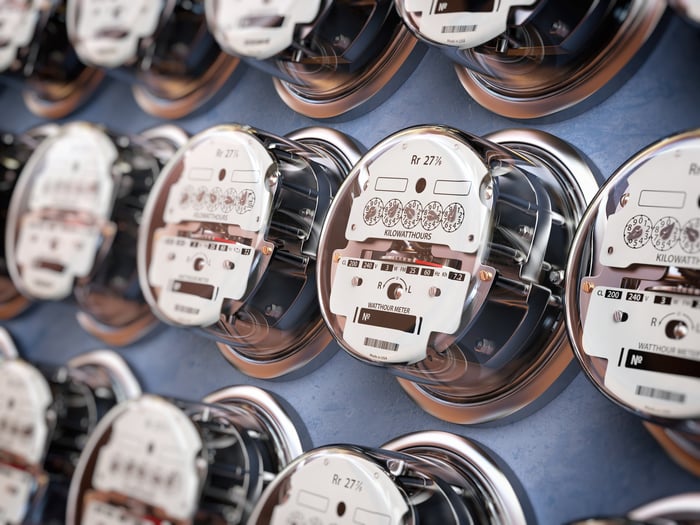It's not a matter of if the stock market will crash again; it's simply a matter of when.
Since the beginning of 1950, the benchmark S&P 500 has undergone 38 crashes or corrections of at least 10%. That's a sizable downside move, on average, every 1.87 years. We're never going to know ahead of time when a crash is coming, but the data is pretty conclusive that big downside moves are quite common.

Image source: Getty Images.
The thing to understand is that stock market crashes are also opportunities, even for investors with little tolerance for risk and volatility.
Perhaps the smartest way to put your money to work during a crash is to buy dividend stocks. Since companies that pay a dividend are often profitable and have time-tested operating models, they're well-suited to help investors navigate periods of heightened volatility.
Ideally, investors want to be paid the highest yield possible with the least risk imaginable. But studies have shown that yield and risk are correlated: the higher the yield, the riskier the investment.
But not all high-yield dividend stocks (i.e., those with yields of at least 4%) are bad news. The following four high-yield stocks would all make for safe investments when the next market crash strikes.

Image source: Getty Images.
IBM: 5.4% yield
Though higher-growth tech stocks have lapped Dow Jones stalwart IBM (IBM 1.05%) many times over the past decade, shareholders can always count on its recurring profitability and robust dividend.
IBM waited too long to begin investing heavily in cloud computing. As a result, its legacy software sales have dwindled. Mind you, these legacy segments still generate abundant cash flow, even with modestly shrinking revenue. IBM has been able to reduce expenses in these legacy operations to bolster margins in the face of this sales decline.
You can confidently buy into the IBM turnaround story during a crash because of its substantial investments in its hybrid cloud. During the fourth quarter, cloud revenue rose 10%, and it accounted for 37% of total sales. Some of this was organic growth; however, the company also made seven acquisitions in the hybrid-cloud/artificial intelligence space last year. As IBM incorporates higher-margin hybrid cloud sales into the fold, its operating margins will increase, and so will its cash flow.

Image source: Getty Images.
Duke Energy: 4.1% yield
Nothing says "defensive income play" quite like an electric utility stock. Utilities are ultra-boring businesses -- but ones that usually generate boatloads of predictable cash flow. That's why Duke Energy's (DUK 0.77%) 4.1% yield would be a smart addition for income seekers.
Electricity and natural gas are basic-need services for homeowners and renters. No matter how well or poorly the U.S. economy is performing, demand for electricity and natural gas should remain relatively constant. Plus, with Duke's traditional electric and natural gas operations regulated by state public energy commissions, it's easy for the company to predict its annual cash flow and adjust its capital expenditures to ensure sustained profitability.
Speaking of capital expenditures, Duke Energy has laid out a $58 billion, five-year plan to primarily invest in cleaner and renewable energy. By 2025 to 2029, the company expects its five-year total spending on renewable projects could hit $65 billion to $75 billion. This focus on renewables could push its annual average growth rate to as high as 7%, which isn't too shabby for an electric utility.

Image source: Getty Images.
Altria Group: 8.1% yield
You might not think that tobacco stocks are particularly smart investments. After all, adult cigarette smoking rates in the U.S. have been declining for more than five decades, and a handful of developed countries around the world have all but declared war on Big Tobacco. But when the going gets tough, tobacco stocks like Altria Group (MO 0.12%) keep plugging along with higher per-share profits.
Tobacco contains nicotine. This chemical's addictive quality protects tobacco products from wild swings in demand during recessions. It also allows Altria to pass along price hikes on its premium product (Marlboro), more than offsetting any decline in cigarette shipping volume.
Altria also isn't betting its future on tobacco. The company has invested heavily in tobacco alternatives (e.g., heated tobacco devices). It took a 45% equity stake in Canadian pot stock Cronos Group in March 2019, as well. Though Canadian cannabis derivatives stumbled out of the gate in 2020, Altria will likely work with Cronos to develop, market, and distribute cannabis vape products.
In short, this is one of the safest ultra-high-yield dividend stocks investors can buy during a crash.

Image source: Getty Images.
Annaly Capital Management: 10.5% yield
Lastly, mortgage real estate investment trust (REIT) Annaly Capital Management (NLY -0.32%) would be a wise addition for income-seeking investors in a plunging market.
Mortgage REITs like Annaly are constantly playing the yield curve. These companies borrow at short-term rates and acquire assets for the long-term that have higher yields (e.g., mortgage-backed securities (MBSs)). The difference between the average yield Annaly receives from the MBSs it owns and its borrowing rate is its net interest margin. Typically, the yield curve steepens during the first year or two during an economic recovery, which allows Annaly to reap a higher net interest margin.
What's more, Annaly almost exclusively invests in agency securities. An agency asset is backed by the federal government in the event of default. Even though this added protection drives down yields, it allows Annaly to use leverage to its advantage.
Mortgage REITs have been shunned for nearly a decade, but have all the tools to shine during the next stock market crash.





